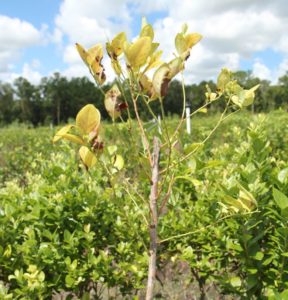Algal Stem Blotch is a blueberry disease that has been on top of mind of researchers throughout the Southeast lately. If you have been to Florida Blueberry Growers Association or North Carolina Blueberry Council, you’ve heard the seminars from researchers such as Renee Allen, UGA and Dr. Phil Harmon, Professor and Extension Specialist UF/IFAS Plant Pathology Department spoke specifically on Algal Stem Blotch. This is a blueberry disease caused by the parasitic green alga Cephaleuros virescens Kunze. Although most blueberry pathogens are fungi, C. virescens is a unique alga in the order Trentepohliales and the phylum Chlorophyta. The disease occurs on many cultivars of SHB (Vaccinium corymbosum) and on the native sparkleberry (V. arboreum) throughout Florida.
According to Dr. Harmon in his Algal Stem Blotch in Southern Highbush Blueberry in Florida, the alga is thought to enter the plant through natural wounds and openings, pruning cuts, or by direct penetration of the cuticle. Once inside the plant, the alga forms colonies called thalli beneath the stem cuticle and visible in red blotchy raised lesions. During hot, humid, and wet conditions, reproductive structures known as sporangiophores emerge and produce zoosporangia that are wind and water splash-dispersed. Each sporangium that lands in a film of water on a blueberry cane can produce 8 to 64 swimming zoospores, also dispersed by water splash. Zoospores are the primary inoculum that initiates new infections, with peak spore production occurring roughly between May and September. Zoospore production can be very prolific, resulting in widespread and numerous summer infections. Symptom development, however, is slow, taking up to one year to produce symptoms. Plants that are stressed by abiotic or biotic factors are more susceptible to infection and subsequent disease development.

Disease Cycle
- Spores are produced May through August
- Infections may take a full year to produce symptoms
- Cane infections persist and produce between 72,000 and 198,000 spores per square cm
- The algae likely gets in plants through wounds
- Disease is most severe on stressed plants
Managing Algal Stem Blotch
- Most modern fungicides are specific to fungi and have no effect on algae or algal stem blotch.
- Spray applications of copper-containing fungicides can help to reduce algal sporulation. These products kill the algal reproductive structures present on the plant and protect healthy canes from infection for a few days after application.
- Copper product sprays should begin after harvest and continue through September. Applications must be done on a regular schedule prior to infection in order to be effective, and spray equipment must achieve good cane coverage. The specific spray schedule and rate will vary by label instruction of product chosen with reapplication intervals ranging from 7 to 28 days.
- Where disease is known to be severe shorten intervals and reduce rates, stay within label. Click Here for Blueberry Application Instructions
- Growers are reporting good results combating Algal Stem Blotch with Magna-Bon CS 2005. Dr. Harmon specifically pointed out Magna-Bon during his presentation and Renee Allen of UGA recommended a systemic fungicide such as CS 2005 to control Algal Stem Blotch!
- Avoid tank-mixes of Cu products with phites and pesticides with EC formulation
Magna-Bon CS 2005 greatly reduces the amount of metallic copper used compared to conventional coppers. Conventional coppers can use upwards of several pounds of metallic copper per acre, while CS 2005 will use less than an 1/4 pound! Build-up of copper in the soil will affect yields in the fruit! Be environmentally friendly by using CS 2005.
If you missed Dr. Phil Harmon’s session at Florida Blueberry Growers Association Fall 2019 Show, Click Here to see his Presentation!

